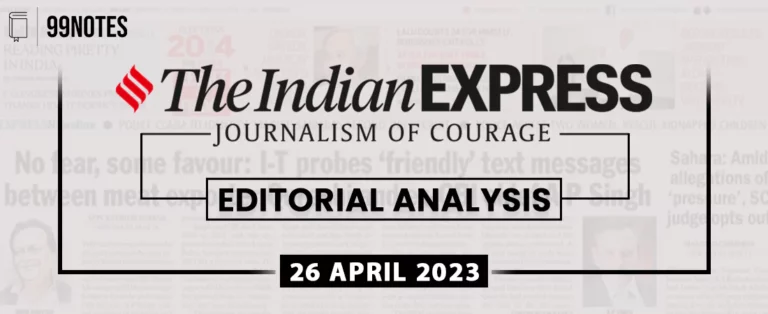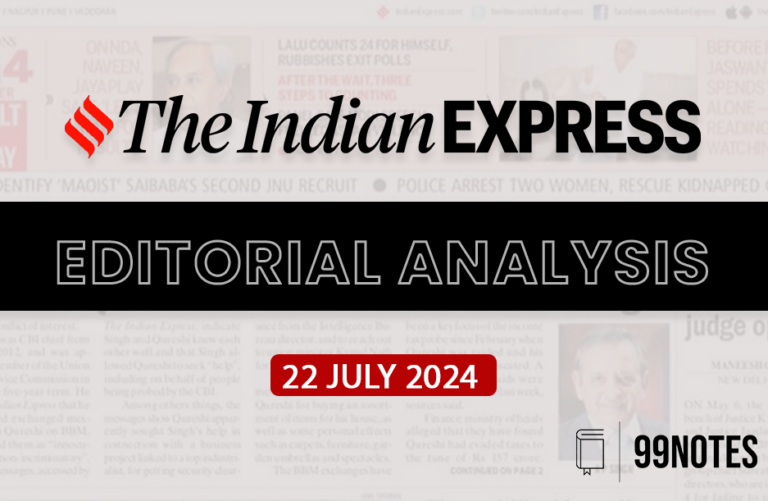4 Jan 2024 : Indian Express
1. Reset the growth priority
| Topic: GS3 – Indian Economy- Issues relating to growth
This topic is not much relevant in the context of Prelims but more for Mains in the context of India’s economic development, discussing challenges, strategies, and models. |
| Context: |
|
Distraction in Economic Discussions: GDP Focus vs. Per Capita Income:
- The focus on reaching a $5 trillion GDP by 2025 is one of the main criticisms levelled against the current discourse about India’s economic future.
- The focus on GDP as a whole, according to the article is a diversion from the real task of development, which should be raising the standard of living for all citizens.
- Therefore, GDP per person should become the primary goal instead of GDP as a whole.
Rethinking Economic Future: Rajan and Lamba’s Perspective on Service Sector Growth:
- The article discusses “Breaking the Mould: Reimagining India’s Economic Future,” a new book by Raghuram Rajan and Rohit Lamba that challenges the traditional route of structural transformation from agriculture to manufacturing to services.
- The authors explore if India can achieve sustainable development by giving the growth of the service sector precedence over that of industry.
Challenges in Manufacturing Sector Growth: India’s Unique Development Path
- The growth of the manufacturing sector has proven difficult in India, where its output and employment share of manufacturing has plateaued at 20% or less.
- India seems to be making the direct shift from an agrarian to a service-based economy, in contrast to the conventional trajectory seen in industrialised and industrialising economies.
Service Sector Growth Potential: Global Business Service Opportunities
- Thanks to developments in information technology, Rajan and Lamba see a chance for India in the business services sector.
- India is playing an increasingly important part in the global supply chain as a result of multinational corporations outsourcing their needs for business services. The difficulty, though, is in doing this on a large scale.
Looming Employment Crisis: Urgent Need for Job Creation
- India adds 8–10 million new workers a year, most of whom have higher levels of education.
- This article highlights how urgent it is to create jobs.
- The unemployment rate as of right now is alarming, particularly for young people between the ages of 15 and 24, which emphasises the urgency of acting quickly to encourage private firms to create jobs on a large scale.
Evaluating Service-Led vs. Manufacturing-Led Models: Skill Deficit and Job Quality
- The article explores the comparison of a traditional manufacturing-led approach with a service-led development model. It points out that India’s present service industry is divided, with low value-added, low-skill services creating jobs and high-tech services seeing the most output increase.
- The article asserts that the creation of jobs in the service sector does not correspond with the financial goals of the younger labour force.
Skill Deficit Challenge: Sustained Investment in Higher Education
- One of the biggest challenges facing India is addressing its talent gap, since most STEM graduates lack the necessary skills to find employment.
- In order to develop a skilled labour force that can satisfy the demands of higher human capital industries, sustained investment in higher education is stressed.
Immediate Solutions: Balancing Service Sector Vision and Manufacturing-Led Models
- The article expresses apprehension regarding the 10-15 year timescale for Rajan and Lamba’s back-office-led service sector model to materialise, albeit acknowledging its potential.
- The impending job issue is being addressed immediately, with a focus on the necessity of a comprehensive strategy that incorporates both the manufacturing and service sectors.
PLI Scheme Evaluation: Employment-Linked vs. Production-Linked Incentives
- The Production-Linked Incentive (PLI) programme is assessed in this article as an effort to address the present employment crisis.
- There are worries that because the programme is production-linked rather than employment-linked, it might not create enough jobs.
- Concerns are also raised concerning the enterprises that stand to gain from the incentives’ long-term commitment.
Comprehensive Action Needed: Beyond PLI Schemes
- The article’s conclusion emphasises how urgent it is for India to move beyond the PLI initiatives and integrate ideas from the manufacturing and service sectors.
- Encouraging private enterprise to grow is essential for this, which calls for changes to labour and land regulations.
- In addition, it is believed that in order to prevent India’s demographic dividend from becoming a demographic curse, the skill gap must be filled by increasing funding for postsecondary education.
| PYQ: Faster economic growth requires increased share of the manufacturing sector in GDP, particularly of MSMEs. Comment on the present policies of the Government in this regard. (150 words/10m) (UPSC CSE (M) GS-3 2023) |
| Practice Question: Evaluate the feasibility of prioritizing service sector growth over traditional industrial growth in achieving sustainable development. Additionally, discuss the role of initiatives like the Production-Linked Incentive (PLI) scheme in addressing India’s employment crisis. (200 words/12.5 m) |
2. Don’t neglect the force
| Topic: GS3 – Internal Security- Various Security forces & agencies and their mandate.
This topic is not much relevant in the context of Prelims but more for Mains in the context of the challenges being faced by the central armed police forces. |
| Context: |
|
Leadership Selection Challenges:
- Adhocism and the lack of clear guidelines are cited in the article to highlight problems with the selection procedure for top leaders in India’s central armed police forces (CAPFs).
- The article expresses concern about the resentment that results from the appointment of novice officers while highlighting the importance of having experienced leaders who can inspire and drive staff.
Delay in Top-Level Appointments:
- The delay in selecting successors to prominent positions following the retirement of current occupants has been brought up as another major worry.
- The article cites cases where these posts went unfilled for months at a time, which had a negative impact on the productivity and morale of the CAPFs.
- The criticism of the government’s alleged indifference to these delays highlights the significance of making decisions on time.
Deployment and Training Challenges
- The negative effects of the CAPFs’ almost year-round deployment, which result in training neglect, are discussed in the article.
- Professional standards have declined as a result of the deployment of forces for internal security activities, notwithstanding pledges for training purposes.
- To make sure the troops are ready for a variety of situations, it is important to emphasise the necessity of a balanced approach to training and deployment.
Conclusion:
- The government should take action to resolve the complex problems that the CAPFs are experiencing, the article’s conclusion urges.
- The necessity of an all-encompassing commission to look into and suggest both immediate and long-term ways to improve the efficiency and performance of the forces is emphasised.
- Highlighting the possible consequences if these worries are not sufficiently addressed, the significance of upholding a high standard of performance is emphasised in order to manage internal security difficulties.
| About Central Armed Police Force (CAPF) |
|
| PYQ: What are the internal security challenges being faced by India? Give out the role of Central Intelligence and Investigative Agencies tasked to counter such threats. (250 words/15m) (UPSC CSE (M) GS-3 2023) |
| Practice Question: What are the key challenges faced by the central armed police forces (CAPFs) in India? How can systemic reforms be implemented to enhance the performance and effectiveness of CAPFs. (250 words/15 m) |






